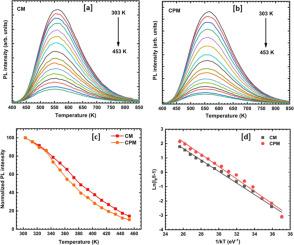Self-emitting yellow phosphor with enough quantum efficiency and thermal stability for light emitting diodes
IF 3.8
Q2 CHEMISTRY, PHYSICAL
引用次数: 0
Abstract
To get high quality white light from the combination of blue light emitting diode (LED) and yellow emitting YAG phosphor is still an issue. Herein, we report a self-emitting Zn3(VO4)2 yellow phosphor synthesized by combustion method (CM) and co-precipitation method (CPM). Urea was used as a fuel for combustion and sodium hydroxide was used as precipitating agent for co-precipitation route. Under near UV excitation, the phosphors emit in the yellow region with an asymmetric emission band towards the higher wavelength in the range from 400 nm to over 800 nm due to the charge transfer transition of an electron from the oxygen to the tetrahedra VO4 with Td symmetry. The luminescence intensity for the CPM synthesized phosphor was much higher than the CM synthesized phosphor. Temperature dependent PL results suggested that the phosphor is thermally stable and retain its 80 % of the initial brightness at 353 K. The quantum efficiency of the CPM synthesized phosphor (∼ 33 %) is also most double the CM synthesized phosphor. The overall results suggest that a UV converted yellow emitting phosphor could be a potential alternative for the combination of blue and green phosphor used in WLED. As a result, the efficiency of the white LED can be enhanced by reducing the probability of the reabsorption.

具有足够量子效率和热稳定性的自发光黄色荧光粉,适用于发光二极管
要从蓝色发光二极管(LED)和黄色发光 YAG 荧光粉的组合中获得高质量的白光,仍然是一个问题。在此,我们报告了一种通过燃烧法(CM)和共沉淀法(CPM)合成的自发光 Zn3(VO4)2 黄色荧光粉。燃烧法以尿素为燃料,共沉淀法以氢氧化钠为沉淀剂。在近紫外光的激发下,荧光粉在黄色区域发光,在 400 纳米到 800 纳米的范围内,由于电子从氧转移到具有 Td 对称性的四面体 VO4 上的电荷转移,荧光粉向高波长方向发出不对称的发射带。CPM 合成荧光粉的发光强度远远高于 CM 合成荧光粉。与温度相关的 PL 结果表明,这种荧光粉具有热稳定性,在 353 K 时仍能保持 80% 的初始亮度。CPM 合成荧光粉的量子效率(33%∼)也是 CM 合成荧光粉的两倍之多。总体结果表明,紫外线转换黄色发光荧光粉可以替代 WLED 中使用的蓝绿荧光粉组合。因此,可以通过降低再吸收的概率来提高白光 LED 的效率。
本文章由计算机程序翻译,如有差异,请以英文原文为准。
求助全文
约1分钟内获得全文
求助全文
来源期刊

Chemical Physics Impact
Materials Science-Materials Science (miscellaneous)
CiteScore
2.60
自引率
0.00%
发文量
65
审稿时长
46 days
 求助内容:
求助内容: 应助结果提醒方式:
应助结果提醒方式:


